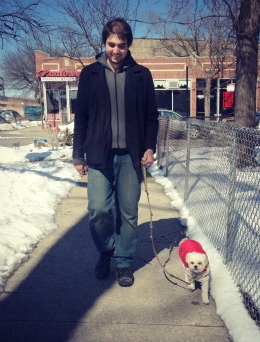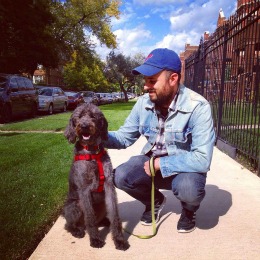January 12, 2016
viagra moclinical.com
 Is there any activity more closely associated with dog ownership, especially urban dog ownership, than walkies? If new dog owners go in knowing nothing else, they have already had it hammered into them that they must walk their dog religiously.
Is there any activity more closely associated with dog ownership, especially urban dog ownership, than walkies? If new dog owners go in knowing nothing else, they have already had it hammered into them that they must walk their dog religiously.
This might seem like a funny thing to question in a guest blog for a dog-walking company, but: why?
Elimination? Sure, especially if you don’t have a yard. Exercise? OK, though most dogs don’t even breathe heavily at the pace we two-leggers set. Socialization? Maybe, especially for puppies, but outings to achieve positive exposure don’t necessarily have to involve the act of walking.
I think the real value in walks for dogs is probably the same as it is for people. Yes, it’s good to move, but also: mental stimulation, a change of scenery, the chance to engage at leisure with the outside world.
When adult humans go for a walk, we choose our own path, set our own pace, and stop as often as we please to investigate what interests us. It’s easy to take for granted these fundamental pleasures of moving through the world. But the way many dogs are walked hardly allows for them. Especially in cities, many are marched in a straight line on a leash that’s always short and always tight, and often carries the implied threat of pain or discomfort if they stray from the boring concrete path their humans prefer or even stop to sniff without permission.
If someone “walked” me this way, I’m fairly sure I’d be a nervous wreck.
I’m not advocating that we all start letting our dogs drag us down the block and pick up every chicken bone they can snuffle out. But I do advocate compromise. Teach your dog to walk with you in a way that’s safe for you and those around you, and lets you enjoy your walk, but that within those parameters lets your dog enjoy it as much as possible.
The process of finding that happy medium is going to be tailored to each dog and human, but here are a few places to start.
Attention first. In the initial weeks or even months with a new dog, getting from point A to point B on a walk is the wrong focus. Teach your dog that wherever you are, paying attention to you is always worthwhile.
Lighten up on the leash. The more tension you put on your end, the more tension the dog will put on his. It feels counterintuitive, but putting slack in the leash will often decrease the dog’s motivation to pull or jump.
I was at the hair salon recently, and while the stylist was blowing out my hair, as usual, she pulled it straight with a brush, hard enough to pull my whole head to the side. As I’ve done hundreds of times before, without a second thought, I pulled my head back in the opposite direction to compensate.
This time, though, I did give it a second thought. I thought, “This is exactly what dogs do when we pull on the leash.”
I asked the stylist if anyone had ever failed to pull back. She said it had happened just a few times in her career, and that it had totally freaked her out. (I think her exact words were: “What’s wrong with you? Why can’t you hold your head up? Are you a baby?”)
Restraint is actually used by some trainers to get fast forward motion in dogs—have somebody hold ’em back, call ’em, and then they’re spring-loaded when you let go. This is not what you want when greeting other dogs or people on the street.
Restraint can also make a dog feel trapped in a situation he would otherwise prefer to move away from. If we all walked tigers instead of dogs, we would all know better than to make an animal feel trapped.
Some dogs would really just rather walk four feet away from you than three, and for those dogs just putting slack in the lead can start to help them settle into a nicer pace. For others, it’s more complicated.
 Give him a reason to walk with you. Just because you keep the leash slack doesn’t mean the dog will—especially if pulling it tight is how the dog has already learned to get closer to what he wants. So once you’ve committed to keeping the leash loose, you also need to teach the dog that there’s a reason for him to do his part. Once he’s able to pay attention to you on leash in a given environment, start to reinforce walking two-to-four feet away from you on a six-foot leash.
Give him a reason to walk with you. Just because you keep the leash slack doesn’t mean the dog will—especially if pulling it tight is how the dog has already learned to get closer to what he wants. So once you’ve committed to keeping the leash loose, you also need to teach the dog that there’s a reason for him to do his part. Once he’s able to pay attention to you on leash in a given environment, start to reinforce walking two-to-four feet away from you on a six-foot leash.
Leash walking is one of the most undoglike behaviors we expect dogs to learn, so reinforce as few steps at a time as you need to to keep the dog successful at first. Use something he wants more than whatever else the environment is offering. (What’s “more reinforcing” than the environment is individual to each dog, but in most cases, it won’t be kibble. Or Zukes.) As the dog gets good at that, gradually ask for more. Over time, you’ll be able to fade out the “jump-start” reinforcers in favor of the natural reinforcers for walking.
Right is fine, and so is in front of you. The tradition of dogs walking on the left side comes from military training: you kept the dog where your firearm wasn’t. We may have to reinstate this soon, as America arms itself to the teeth, but for now, don’t sweat the side.
I do recommend teaching a “default” position to one side or the other, so the dog doesn’t trip you darting to and fro, and I mostly establish it by means of always delivering my reinforcers on that side. (Generally if chicken always shows up in a certain place, so will the dog.) Many of my right-handed clients prefer to use that hand to deliver treats, so walking the dog on that side makes it easy to deliver them efficiently and with good timing.
You can also chuck out the idea that your dog needs to walk right at your side or behind you. I like my dog to walk a length or two in front of me, so I can read her body language clearly and have plenty of advance notice when something in our path is starting to pique her interest.
Curve. Walking head-on into other dogs or strangers makes a lot of dogs worried. (See tigers, above.) Proactively curve out around oncoming traffic, reinforce attention, then decide between the two of you who want to meet, and whether they want to meet you.
Let ’em sniff. Sniffing is to dogs as seeing is to people. Dogs left to their own devices follow their nose, and getting to smell interesting stuff is a powerful natural reinforcer. Get ahead of it. Alternate 5-10 reps of reinforcement for walking near you with opportunities to sniff that the dog doesn’t even have to ask for.
If walking scares your dog, don’t do it. If going outside or walking in a typical city environment is provoking fearful or aggressive behavior (which is almost always rooted in fear), give him as much of a break as possible, and seek help from a qualified trainer and/or veterinary behaviorist. Find other ways to provide physical exercise and mental stimulation, and let the pros help you make a plan to help your dog feel better about what he’s afraid of.
Are you interested in dog walking services and live in Chicago?
Contact us today at support@rover-time.com or visit our Home Page for more information!
Learn more about or contact Kiki Yablon at Dog Training by Kiki Yablon.

Recent Comments